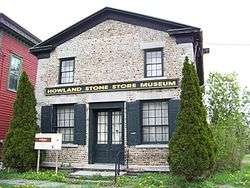Howland Cobblestone Store
The Howland Cobblestone Store, also known as the Howland Stone Store Museum, is an early 19th-century store significant for its unusual cobblestone architecture. It was added to the National Register of Historic Places in 1994.[1] At the time of its nomination, the owners were in the process of restoring its original appearance by removing the stucco that had covered the cobblestones since the 1850s.[2] That process has since been completed.
Howland Cobblestone Store | |
 | |
  | |
| Location | Scipio, New York |
|---|---|
| Coordinates | 42°45′40″N 76°37′17″W |
| Built | 1837 |
| Architect | unknown |
| Architectural style | Federal |
| MPS | Cobblestone Architecture of New York State MPS |
| NRHP reference No. | 94000171[1] |
| Added to NRHP | March 17, 1994 |
The store was originally owned by Slocum Howland, a Quaker, abolitionist, prohibitionist and suffragist. Among the items sold in his store was the cast iron plow, invented locally by his brother-in-law Jethro Wood.[2]
Cobblestone architecture was highly developed in New York State. A survey identified 660 cobblestone structures in 21 New York counties. There may be approximately 300 elsewhere in the United States, concentrated in Vermont, Ohio, Michigan, and Illinois, all areas of similar Northern Tier culture. Many people from Vermont and New York moved west into the upper Midwest states. [3]
See also
References
- "National Register Information System". National Register of Historic Places. National Park Service. January 23, 2007.
- Todd, Nancy L. (January 1994). "National Register of Historic Places Inventory/Nomination: Howland Cobblestone Store". Retrieved 2008-05-04. and Accompanying 3 photos, exterior, from 1993
- Nancy L. Todd (March 1992). "National Register of Historic Places Multiple Property Documentation Form: Cobblestone Architecture of New York State" (pdf). National Park Service. Cite journal requires
|journal=(help)